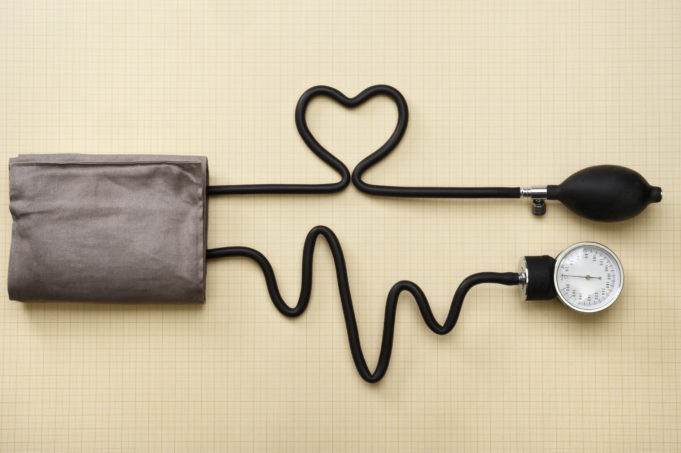I check people’s blood pressure A LOT and my patients often look nervously at me and ask, “Is it alright?” Systolic, diastolic, hypotension, hypertension; the subject of blood pressure can be confusing. What do all those number actually mean? Blood pressure (bp) measurement is no longer solely the domain of the GP. You can have your bp checked in the supermarket, a chemist, often at work or even at a football match. More and more of us have bp machines at home. As runners we’re generally pretty interested in our health and whilst we know that running is good for our blood pressure I thought it would be helpful to look at the subject in more detail. What does it mean? Why do we check it? What can go wrong?
What is blood pressure?
Think of your heart as the boiler and your blood vessels as the pipes. Your bp is simply a measure of the pressure in the pipes. A bp reading consists of two numbers.
The first is called the systolic value. This is the pressure in the arteries (blood vessels taking blood away from the heart) when the heart is contracting and is at it’s most forceful. It’s the maximum pressure in the pipes.
The second number is the diastolic value. This is the pressure in the arteries when the heart is relaxing between beats. It’s the minimum pressure in the pipes.
Bp is recorded as systolic/diastolic so you might see a reading like 120/70. It‘s measured in millimeters of mercury (mmHg). So the maximum pressure in this person’s arteries is 120mmHg and the minimum is 70mmHg. Easy!
Why do we check blood pressure?
We’re most interested in spotting high bp. This is called hypertension. Hyper means too much, so, too much tension or pressure in the system. Hypertension causes death and disease and it is preventable. If we can pick up and treat high bp we can reduce death and illness in the population. At least a quarter of adults and more than half of over 60s have high bp.
We all know what happens when the pressure in the pipes is too high for any length of time; the pipes get damaged, the boiler packs up and the radiators don’t get any heat. High bp can lead to strokes, heart disease, kidney damage and early death. You can see why it’s so important to spot it. Hypertension rarely causes symptoms so many people have it but don’t know about it. All adults should have their bp checked at least every five years.
What’s a normal blood pressure?
An average healthy adult should have a blood pressure of about 120/80 or below.
There isn’t a clear cut off point when bp becomes too high but the higher it gets the more damage it does. If your bp reading (either the systolic or diastolic) is higher than 140/90 then you might have hypertension and you’ll need to have some further tests to confirm this. This might involve wearing a special bp machine for 24 hours to get a clearer picture of what your average bp is over the course of the day and night.
If you already have medical problems then your GP or nurse will be able to advise you what a safe bp is for you as you may need a lower target.
What about low blood pressure?
Let’s not forget low bp, also called hypotension (hypo meaning too little, so, too little pressure and tension in the system).
A bp reading of 90/60 or less is classed as low.
Many people have low blood pressure but no symptoms at all. Some people may feel light headed, dizzy or faint often if they stand up quickly or stand still for any length of time. If you don’t have any symptoms then hypotension doesn’t need any treatment. If symptoms are frequent then you should see your GP.
What happens to blood pressure when you run?
When you run your bp actually goes up. The muscles are craving oxygen, more blood is needed to supply this so the heart pumps harder and more frequently. This causes a rise in the systolic pressure. Interestingly the diastolic pressure doesn’t rise much, if at all in those with a usually normal bp. Warming up allows cardiac changes to happen more gradually. If you settle into a steady intensity as you might do during a long slow run then the systolic pressure may reduce a little from the high values at the start of the run.
When you stop then your bp comes back down to normal. This can happen suddenly in some people making them feel faint or even collapse on the line. It’s always best to warm down with a slow jog and a walk to allow time for pressures to normalize slowly.
Why is running good for blood pressure?
Regular exercise like running will help to keep your blood pressure normal and also reduce it if it’s too high. The amount it reduces varies between people but about 5mmHg is a guide and may be enough to stop the need for medication. The heart is a muscle which needs to be used and with consistent training it will become stronger and more efficient. Less effort will be required to pump a bigger volume of blood and pressure in the system is therefore reduced. Growing muscles require a larger blood supply and new small blood vessels called capillaries form to provide this. Other blood vessels enlarge too due to hormonal triggers and nerve pathways. There’s effectively more and bigger pipes in the system which in turn reduces the pressure.
You need to continue to exercise regularly to maintain the benefits.
Some safety notes:
This is an overview of the basics of blood pressure for you. If you’ve been diagnosed with high blood pressure then you should speak to your GP about whether it’s safe for you to run. Your bp may need to be stabilised with treatment first. You may also be advised to avoid lifting heavy weights.
Ref: NICE Guideline CG127 Aug 2011






